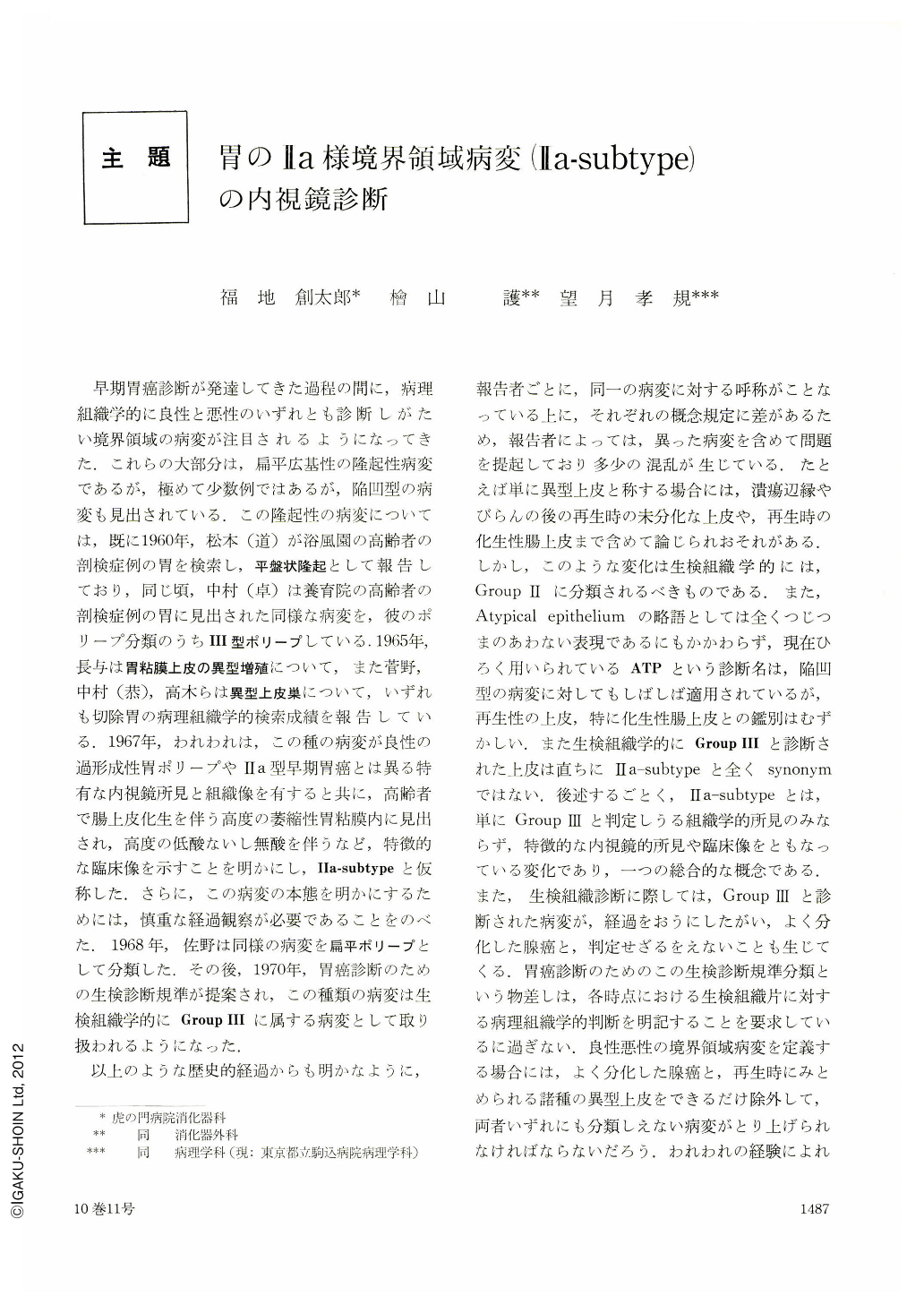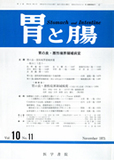Japanese
English
- 有料閲覧
- Abstract 文献概要
- 1ページ目 Look Inside
早期胃癌診断が発達してきた過程の間に,病理組織学的に良性と悪性のいずれとも診断しがたい境界領域の病変が注目されるようになってきた.これらの大部分は,扁平広基性の隆起性病変であるが,極めて少数例ではあるが,陥凹型の病変も見出されている.この隆起性の病変については,既に1960年,松本(道)が浴風園の高齢者の剖検症例の胃を検索し,平盤状隆起として報告しており,同じ頃,中村(卓)は養育院の高齢者の剖検症例の胃に見出された同様な病変を,彼のポリープ分類のうちⅢ型ポリープしている.1965年,長与は胃粘膜上皮の異型増殖について,また菅野,中村(恭),高木らは異型上皮巣について,いずれも切除胃の病理組織学的検索成績を報告している.1967年,われわれは,この種の病変が良性の過形成性胃ポリープやⅡa型早期胃癌とは異る特有な内視鏡所見と組織像を有すると共に,高齢者で腸上皮化生を伴う高度の萎縮性胃粘膜内に見出され,高度の低酸ないし無酸を伴うなど,特徴的な臨床像を示すことを明かにし,Ⅱa-subtypeと仮称した.さらに,この病変の本態を明かにするためには,慎重な経過観察が必要であることをのべた.1968年,佐野は同様の病変を扁平ポリープとして分類した.その後,1970年,胃癌診断のための生検診断規準が提案され,この種類の病変は生検組織学的にGroup Ⅲに属する病変として取り扱われるようになった.
以上のような歴史的経過からも明かなように,報告者ごとに,同一の病変に対する呼称がことなっている上に,それぞれの概念規定に差があるため,報告者によっては,異った病変を含めて問題を提起しており多少の混乱が生じている.たとえば単に異型上皮と称する場合には,潰瘍辺縁やびらんの後の再生時の未分化な上皮や,再生時の化生性腸上皮まで含めて論じられおそれがある.しかし,このような変化は生検組織学的には,Group Ⅱに分類されるべきものである.また,Atypical epitheliumの略語としては全くつじつまのあわない表現であるにもかかわらず,現在ひろく用いられているATPという診断名は,陥凹型の病変に対してもしばしば適用されているが,再生性の上皮,特に化生性腸上皮との鑑別はむずかしい.また生検組織学的にGroup Ⅲと診断された上皮は直ちにⅡa-subtypeと全くsynonymではない.後述するごとく,Ⅱa-subtypeとは,単にGroup Ⅲと判定しうる組織学的所見のみならず,特徴的な内視鏡的所見や臨床像をともなっている変化であり,一つの総合的な概念である.また,生検組織診断に際しては,Group Ⅲと診断された病変が,経過をおうにしたがい,よく分化した腺癌と,判定せざるをえないことも生じてくる.胃癌診断のためのこの生検診断規準分類という物差しは,各時点における生検組織片に対する病理組織学的判断を明記することを要求しているに過ぎない.良性悪性の境界領域病変を定義する場合には,よく分化した腺癌と,再生時にみとめられる諸種の異型上皮をできるだけ除外して,両者いずれにも分類しえない病変がとり上げられなければならないだろう.われわれの経験によればこのような病変は大部分は隆起型であり,われわれがかりに提起しているⅡa-subtypeに属すると考えられる.
Flat sessile polypoid lesion simulating type Ⅱa of early gastric cancer accounts for the majority of the borderline lesion between malignancy and benignancy. In addition to the endoscopic findings and histologic study of biopsied specimens its characteristic clinical background have led us to assume that this lesion be an independent disease entity. Tentatively we call it as Ⅱa-subtype of polypoid lesion on the level of clinical diagnosis.
Endoscopic findings of Ⅱa-subtype polypoid lesion consist in low-statured, broad-based elevation mostly less than 2 cm in diameter, although it ranges from as small as 5 mm to more than 3 cm in width. Smaller lesions are of smooth surface, but larger ones are apt to show uniform unevenness as if the gastric areas had been enlarged. The mucosal surface looks pale without any local reddening and is further characterized by the lack of erosive changes.
Endoscopically differentiation from benign polyp is not so difficult; in typical cases it can also be distinguished mostly from type Ⅱa of early cancer that would often show irregular unevenness of the surface. If reddening or erosive change is additionally recognized, diagnosis of cancer is in order. However, in well-differentiated cancer with only slight unevenness of the surface and unaccompanied with erosive changes, differentiation between it and Ⅱa-subtype of polypoid losion may become difficult. A small polypoid lesion about 5 mm in diameter would also be hard to tell from small protrusions of gastritis origin.
The positive results of endoscopy prior to biopsy in 55 cases of Ⅱa-subtype polypoid lesion were 82 per cent, showing that this lesion can be diagnosed mostly by endoscopy alone. Naturally, for more accurate diagnosis histologic study of biopsied specimens is indispensable. However, well-differentiated carcinoma may show in parts tissue hard to discriminate from Ⅱa-subtype of polypoid lesion and erroneous diagnosis could ensure in biopsied materials that are of limited scope and number. It becomes thus neccesary to have comprehensive judgment through periodic follow-up study by means of histologic examination of biopsied specimens including detailed observations of its gross morphology by means of both x-ray and endoscopy.

Copyright © 1975, Igaku-Shoin Ltd. All rights reserved.


